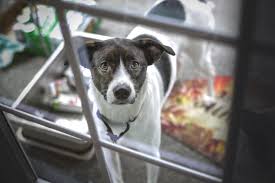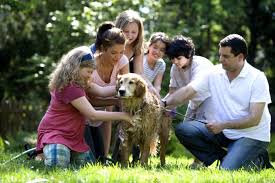 You may be wanting to transition your dog who currently is an inside dog to being outside some or all of the time. The reason you may wish to do this can vary and may include:
You may be wanting to transition your dog who currently is an inside dog to being outside some or all of the time. The reason you may wish to do this can vary and may include:
- your dog is misbehaving inside such as chewing up stuff or toileting inside.
- you may have a baby on the way.
- the landlord or owner of the property doesn’t want a dog inside.
- numerous other reasons
Whatever the reason it doesn’t really matter. What is important is the process. Depending upon how much time your dog currently spends outside you are likely to meet some resistance. Dogs get used to a routine and they may not understand why there is a sudden change. This may result in some acting up and behavior problems such as barking, howling and scratching at the door. It may also cause some psychological stress to your dog such as feeling sad and depressed.
How long the transition will take will depend upon the particular dog. Be patient and understanding with them as they get used to the change in routine.
Tips for transitioning inside dog to outside
Gradually increase time outside
Over the space of a couple of weeks gradually increase the amount of time your dog spends outside. If they are going to be outside most but not all of the time increase outside time until it reaches the average amount of time they will outside.
Also start feeding them outside and put their other possessions outside such as their bed, toys and so on. If you are wanting them to sleep outside but still have some inside time when you home start putting them outside at night time and set a date that they will begin sleeping outside. This way they will be conditioned to being outside when it is dark. If they are to be kept outside fulltime follow the same routine increasing the period of outside time each session.
Social contact
 Dogs are by nature a very social animal. If they are used to spending a lot of time with you inside it may feel like a rejection if they are suddenly outside and spending little time with you or the company of people. Make the effort to spend time with them outside so they know you still care about them. If they are home alone and will be outside, consider getting friends or family to visit them during the day. Alternatively, you can hire a professional pet minding service or even a dog walker to come during the day. For more tips on keeping a dog outside while at work see here.
Dogs are by nature a very social animal. If they are used to spending a lot of time with you inside it may feel like a rejection if they are suddenly outside and spending little time with you or the company of people. Make the effort to spend time with them outside so they know you still care about them. If they are home alone and will be outside, consider getting friends or family to visit them during the day. Alternatively, you can hire a professional pet minding service or even a dog walker to come during the day. For more tips on keeping a dog outside while at work see here.
Provide adequate exercise
It is important to provide the right amount of exercise for your dog so that they are tired. This will help to prevent any behavior problems from developing due to boredom and loneliness. This should include a daily walk. Going for walks with your dog not only provides physical exercise. It provides mental enrichment and a social opportunity for them. This is by way of the sights and smells they come across, meeting other dogs and spending quality bonding time with you. For a guide to how much exercise your particular dog needs see here. If you are unable to take your dog for daily walks, consider hiring a dog walking service.
Comfort Zone
You will need to provide your dog with a safe and secure shelter that can go to sleep and get out of the weather. This will generally be a dog kennel. Ensure you get a kennel that is the right size for your dog. It should be big enough for them to stand up and turn around. However, a dog may not use a kennel that is too big as it doesn’t give them that feeling of security.
Also in the comfort zone, they should have their food and water bowls, bedding and any toys and chews to keep them occupied.
Provide ways to occupy your dog
It is important to provide your dog with stimulation and activities to keep them busy and challenged. One of the best ways to keep your dog occupied is to provide self-entertaining dog toys. For ideas for self-playing dog toys see here.
Providing chew toys or bones will also benefit your dog. Chewing is not only about cleaning their teeth and keeping them occupied. Chewing is also an excellent stress release for dogs. The chewing action releases endorphins to the brain giving them a relaxed and calm feeling. To learn more about the benefits of chewing and the best chew toys for dogs see here.
 Many dogs like to dig. This is a natural instinctive behavior. However, you probably don’t want them digging up your yard. You can’t train an instinctive behavior out of a dog, but you can redirect it. If your dog is a digger it is a good idea to provide them with a digging area such as a digging pit or with toys that simulate the digging behavior. For more on this check out dog toys for diggers.
Many dogs like to dig. This is a natural instinctive behavior. However, you probably don’t want them digging up your yard. You can’t train an instinctive behavior out of a dog, but you can redirect it. If your dog is a digger it is a good idea to provide them with a digging area such as a digging pit or with toys that simulate the digging behavior. For more on this check out dog toys for diggers.
For more ideas on how to keep a dog entertained in the yard see here. Also, don’t forget to spend time outside playing with your dog.
Consider getting them a friend
You may want to consider getting a second dog to provide company for your first dog. This is obviously a big step and a decision that should not be taken lightly. It would be heartbreaking to have to rehome the new dog if things don’t work out. For advise on helping to make this important decision see Should I get a second dog quiz.
Consider safety factors
Ensure your property is well fenced to prevent your dog trying to escape. Dogs can be very resourceful if they are truly wanting to get out. This may include jumping or climbing the fence, digging under the fence or even breaking the fence. If they do manage to make an escape it is important that your dog is microchipped and registered with the local governing body that oversees animal management. It is also a good idea to use a GPS collar so locating your dog is much easier.
DO NOT leave your dog chained up outside. This is extremely unfair and is no life for a dog.
Take the weather conditions into consideration. If you live in an extremely cold make sure that it is suitable for your dog to be outside. If the weather is hot take precautions to prevent the risk of heatstroke and dehydration. See how to keep a dog cool in hot weather for ideas.
Also be aware of the possibility of someone stealing your dog. This is more of a concern than many people realize. Unfortunately, there are some horrible people out there and dogs are often stolen as a bait dog for dog fighting. Some dogs are stolen simply because someone likes your particular breed of dog to keep themselves or to sell for money. Take precautions to ensure your property is secure such as putting a padlock on your gates to stop access to the property.
Ensure that there are no potential safety hazards in the yard. This may include any sharp or dangerous items such as tools or small items that they could swallow and coke on. Also be aware of any poisons such as toxic plants or rodent or slug poisons.
If you are in the process of transitioning your inside dog to outside I hope these tips are of some help. Remember that it is a process and you may need to be patient and understanding of how the change affects them. In general, dogs do adapt to a change in routine or circumstances quite quickly as long as you guide them.